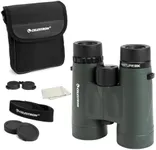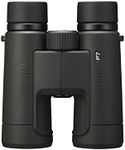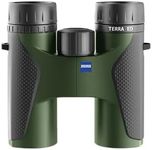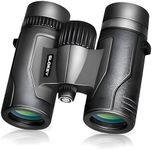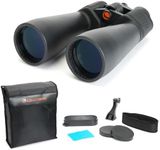Buying Guide for the Best Bird Watching Binoculars
Choosing the right bird-watching binoculars can greatly enhance your bird-watching experience. The right pair will allow you to see birds clearly and comfortably, even from a distance. When selecting binoculars, it's important to consider several key specifications to ensure they meet your needs. Here are the most important specs to look at and how to choose the best fit for you.MagnificationMagnification refers to how much closer the binoculars can make objects appear. For bird-watching, a magnification of 8x or 10x is generally ideal. 8x magnification provides a wider field of view, making it easier to spot birds and follow their movements. 10x magnification offers more detail but can be harder to keep steady. Choose 8x if you prefer a wider view and easier handling, and 10x if you want to see more detail and are comfortable with a narrower field of view.
Objective Lens DiameterThe objective lens diameter is the size of the front lenses, measured in millimeters. Larger diameters (e.g., 42mm) allow more light to enter, providing brighter and clearer images, especially in low-light conditions. However, larger lenses also make the binoculars heavier. For bird-watching, a diameter between 32mm and 42mm is a good balance between image quality and portability. Choose a larger diameter if you often watch birds in dim light or at dawn/dusk, and a smaller diameter if you prioritize lightweight and compact binoculars.
Field of ViewField of view is the width of the area you can see through the binoculars, usually measured in feet at 1000 yards. A wider field of view makes it easier to locate and track birds, especially those that move quickly. Binoculars with a field of view of 300-400 feet at 1000 yards are ideal for bird-watching. Choose a wider field of view if you want to easily spot and follow birds, and a narrower field of view if you prefer more detailed observation of stationary birds.
Close FocusClose focus is the shortest distance at which binoculars can clearly focus on an object. For bird-watching, a close focus distance of 6-8 feet is generally sufficient. This spec is important for observing birds that are nearby, such as those at feeders or in bushes. Choose binoculars with a shorter close focus distance if you often watch birds up close, and a longer distance if you primarily observe birds from afar.
Eye ReliefEye relief is the distance between your eyes and the binoculars' eyepieces while still seeing the full image. This is especially important for people who wear glasses. Longer eye relief (15-20mm) allows for comfortable viewing with glasses. Choose binoculars with longer eye relief if you wear glasses, and shorter eye relief if you do not.
Weight and SizeWeight and size are important for comfort and portability. Heavier binoculars can be tiring to hold for long periods, while lighter ones are easier to carry and use. Compact binoculars are more convenient for travel but may have smaller objective lenses. Choose lighter and smaller binoculars if you prioritize ease of carrying and handling, and heavier ones if you prefer better image quality and don't mind the extra weight.
Durability and WeatherproofingDurability and weatherproofing ensure that your binoculars can withstand outdoor conditions. Look for binoculars that are waterproof and fog-proof to protect against rain and humidity. Rubber armor can provide shock resistance and a better grip. Choose durable and weatherproof binoculars if you often bird-watch in varying weather conditions or rugged environments.


